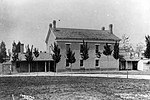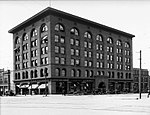LDS Conference Center
20th-century Latter Day Saint church buildingsBuildings and structures in Salt Lake CityEvent venues established in 2000Religious buildings and structures completed in 2000Religious buildings and structures in Salt Lake City ... and 1 more
Religious buildings and structures of the Church of Jesus Christ of Latter-day Saints in Utah

The Conference Center, in Salt Lake City, Utah, is the premier meeting hall for the Church of Jesus Christ of Latter-day Saints (LDS Church). Completed in 2000, the 21,000-seat Conference Center replaced the traditional use of the nearby Salt Lake Tabernacle, built in 1868, for the church's biannual general conference and other major gatherings, devotionals, and events. It is believed to be the largest theater-style auditorium ever built.
Excerpt from the Wikipedia article LDS Conference Center (License: CC BY-SA 3.0, Authors, Images).LDS Conference Center
West Temple, Salt Lake City
Geographical coordinates (GPS) Address External links Nearby Places Show on map
Geographical coordinates (GPS)
| Latitude | Longitude |
|---|---|
| N 40.7725 ° | E -111.8925 ° |
Address
Conference Center
West Temple 60 W
84150 Salt Lake City
Utah, United States
Open on Google Maps










